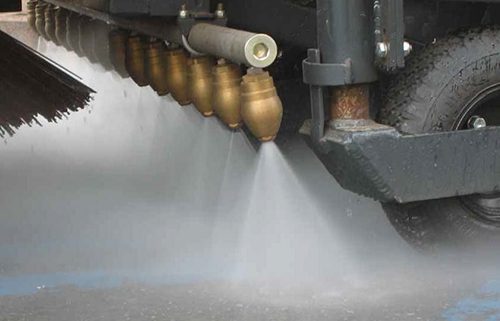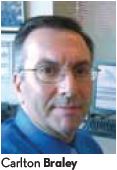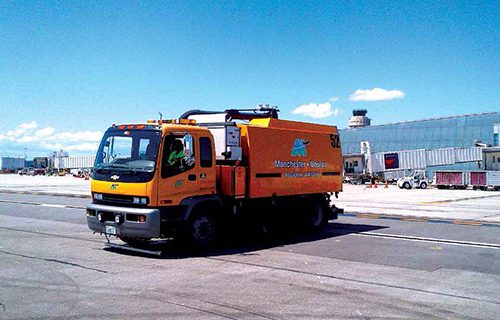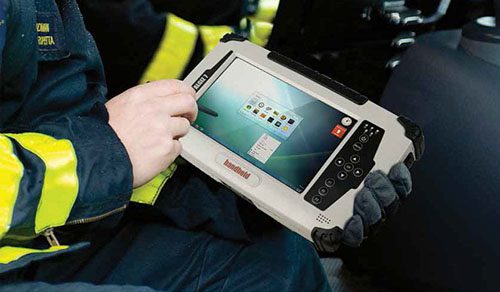 With more than 2.45 million passengers and 176 million pounds of cargo to move last year, Manchester-Boston Regional Airport (MHT) couldn't afford to let weather or wildlife disrupt operations. Fortunately, its Airfield Maintenance Department has developed a variety of measures throughout the years to keep the airport's runways open and safe.
With more than 2.45 million passengers and 176 million pounds of cargo to move last year, Manchester-Boston Regional Airport (MHT) couldn't afford to let weather or wildlife disrupt operations. Fortunately, its Airfield Maintenance Department has developed a variety of measures throughout the years to keep the airport's runways open and safe.
As one might expect, weather is no small factor for the New Hampshire facility, located 50 miles north of Boston. "We average 66 inches a winter, but it seems as if we either get 100 inches or 30," says MHT Maintenance Superintendent Carlton Braley. "Last winter (2012-2013), we got 20 inches of snow in one storm alone."
 factsfigures factsfigures
Project: Ongoing Airfield Maintenance |
Although MHT has used snow-melting pits for about 20 years, it turned up the technology on its strategy two years ago with two new pits from Trecan, each about 40 feet wide and 12 feet deep. Five natural gas heaters maintain a temperature of about 60ø F inside the pits, allowing the system to melt up to 300 tons of snow and ice per hour.
The high-tech aspect of MHT's newer pits is the computer tablets that snow plow operators use to monitor and operate them. After maintenance personnel turn on the equipment manually and inspect the system on foot to confirm everything is working properly, they can operate the pits from inside their vehicles – protected from the harsh weather that necessitates their very use. With tablets in hand, operators can remotely increase or decrease the system's melting capacity, depending on the amount of snow being pushed into the pits.
In addition to increasing operator safety and comfort, the tablets also allow the airport to run the burners only when necessary. "Once we started using this system, we noticed an immediate reduction in our fuel costs the following winter," Braley reports.
Handheld tablets also figure prominently into MHT's wildlife management strategy. Braley considers the Ultima Scarecrow system from Sherwin Industries an important part of daily efforts to control the airport's bird population. "The onboard tablet computer allows us to select the species we are looking to disperse, and the computer produces an audible distress call of that species that will scare away the intended bird(s)," he explains.
Other species must be lured away from the field, so crews set up off the airport and select an attracting call to entice the birds elsewhere. "(It) works both ways," Braley notes.
The tablet also collects a wealth of data, adds Braley. The system records activities from specific shifts and allows personnel to print time-stamped reports with information about specific bird/animal species, total count of dispersals, observations of flyovers, carcass recoveries and various dispersal methods used. In addition, the system maps the locations of all reported activities.
"We use it in conjunction with habitat management methods and scare-shot techniques to help reduce the number of birds around the airfield," he notes.
Self-Spec'd Equipment
In some cases, MHT has taken the reigns and devised new systems to improve maintenance procedures. Frustrated with the cost of acquiring and operating separate vehicles for rubber removal, glycol recovery, cleaning markings and collecting sand, airport personnel worked with an equipment manufacturer to develop a customized vehicle that could perform all of these jobs – and more.
Although Braley is thrilled with the result, he acknowledges that getting the machine produced took a lot of trial-and-error. The first manufacturer that airport personnel approached about renovating a street sweeper to also perform rubber removal turned them down flatly. "They said it was too far of a stretch," Braley recalls. "Then we went to Fortbrand, (an equipment distributor) with whom we have had a terrific working relationship over the years."
Fortbrand customized a Beam truck MHT was primarily using for glycol recovery to also remove rubber from runways and taxiways. "They added a third broom and a large liquid tank to hold the cleaning solution," explains Braley.
 After testing the modified truck for a few months, MHT maintenance personnel suggested a few additions, such as a hot-water tank, a burner to heat the water and high-pressure nozzles. In spring 2008, the modified VX800 truck was delivered. (The upgraded model sold today is the A8000.)
After testing the modified truck for a few months, MHT maintenance personnel suggested a few additions, such as a hot-water tank, a burner to heat the water and high-pressure nozzles. In spring 2008, the modified VX800 truck was delivered. (The upgraded model sold today is the A8000.)
MHT crews are enthusiastic about the performance of the multipurpose vehicle. "With a 55-gallon tank, we can do three to four hours of rubber removal an evening, with no overtime," Braley reports. "It takes us less than 30 minutes to clear a runway. We accomplish about 20,000 square feet of rubber removal each evening. Depending on the severity, we choose to clean a wider path or a longer path. The square footage remains the same. We could double the production, but it would put undo stress on the morning schedule; and with our current rubber removal procedure, we never reach a critical buildup of rubber."
Although MHT is open 24 hours a day, the last flight usually arrives by 1 a.m. This allows crews to remove rubber from the runway without disrupting traffic. The overnight/early morning schedule also helps minimize the evaporation of chemicals.
By reducing overtime and burning less fuel, the airport's multipurpose vehicle helps reduce maintenance costs, notes Braley. "For rubber removal, it is less expensive per square foot. Our only expense now is the cost of the chemicals."
Besides removing rubber, the truck also moves about 1,000 tons of sand each winter and collects fluid from the airport's secondary aircraft deicing locations. Crews use the vehicle's high-pressure wand to clean snow melters, catch basins, manholes, trenches and sidewalks. It has also proved helpful in prepping airfield markings for maintenance.
Human Help
MHT employs 25 full-time airport operations and maintenance specialists, plus 12 more on the "street side" for terminal maintenance. In addition, it hires temporary and seasonal employees for winter operations.
Interestingly, the local union seems to accept, even embrace, this arrangement. "We have a good working relationship with the union here," Braley explains. "They don't want to work 24 hours straight in a storm, and they know keeping the airport open is a priority, and that safety is extremely important."
Helping the dynamic, MHT often fills permanent positions from the temporary and seasonal worker pool when more permanent employees are needed. "They are already familiar with our operation, and we have first-hand knowledge of their work ethic," Braley notes.
During winter, temporary workers may log 32 to 40 hours per week. Some come from nearby Daniel Webster College, which offers aviation-related degrees. Students gain "real-world" airfield experience while plowing snow, clearing brushes or performing other assistance functions. They don't, however, drive the airport's large multifunction truck until they have at least a few years of experience.
"It takes a while for our seasonal workers just to learn the airfield," Braley explains. "We put them in the cradle, and start them with light equipment. If we are using three snowplows to clear a runway, they might be in the middle plow, and ride along with another experienced driver. They won't drive a plow until we are sure they are ready."
Braley also stresses training for permanent Maintenance Department personnel. Ideally, he wants every member of the crew to be able to operate all 70 of the airport's maintenance vehicles, including the VX800. When the airport first purchased the multipurpose Beam truck, Fortbrand provided training for both operators and mechanics. "Each person on our staff got at least eight hours of training, and many received a lot more," Braley recalls. These days, he relies on senior operators to train new employees. "For rubber maintenance jobs, we might train someone for three nights to make sure they get the hang of it," he explains.
Industry Forecast
Braley, a member of the International Aviation Snow Symposium Committee, anticipates technology to play an important role in increasing airfield safety. "I expect more tablets and even smartphones to be used in the future," he says. "My only reservation is that plow operators may become distracted by them, and not pay attention to what is going on around them."
He also predicts that more organized training, including a certificate program, will become a reality for airfield workers.
On the equipment front, he foresees better tools for removing snow around airport lights. "The new LED lights being installed in many airports are more expensive to replace, but will last 50,000 hours compared to 12,000 hours with standard incandescent lights," he explains. "They will eventually save airports quite a bit of money."
He also expects more sophisticated and accurate weather forecasting to help airport maintenance staffs stay on top of challenging conditions: "We should have a better idea of when storms will hit, and how long they will last."
Above all, he predicts that multipurpose equipment such as MHT's Beam truck will become more popular at other airports, although he acknowledges that their price remains a challenge.
"Receiving AIP funding from the FAA for certain specialized equipment can be challenging," Braley says. "Currently, the FAA may provide grant money for snow-removal equipment, but not for MTEs (multiple task equipment). Hopefully, that will start to change."
With or without federal funds, Fortbrand Executive Vice President Alan J. Stearn encourages airport directors to consider total cost when evaluating equipment prices: "Airports need to think about long-term savings in labor and the costs of maintaining many vehicles, since this machine (the A8000) can do the functions of several machines with one operator."
While some operators still prefer the base unit, which is designed for glycol recovery, more and more want the multifunction configuration, notes Stearn. Over the past year, the company has delivered six A8000s to a firm that services several Canadian airports.
Andrew Perrone, director of airfield equipment sales for Fortbrand, is similarly enthusiastic about the A8000 and its larger cousins, the A9000 and A12000: "In the past, one vehicle dedicated just for glycol recovery would sit in a garage most of the year. With the Beam, every function is within the vehicle; there are no attachments. It is ready to go."
Perrone also encourages airports to analyze the equipment's long-term benefits, as MHT did: "It will eventually pay for itself and save money in the long run, but the initial outlay must be
overcome."


